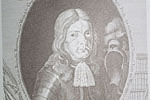Famous Slovenian Scientists
Slovenia's scientific, research and innovation activities are exceptionally multi-faceted and, because of the maintenance of very high standards, recognised across the world. The research achievements of Slovenes are nearly five hundred years old and Slovenian researchers started joining various associations already in the 17th century.
The development of science, medicine and technology was particularly stimulated by the discovery of mercury in Idrija in 1490.
In 1693, the first scientific organisation was founded in Ljubljana, the Academia Operosorumm Labacensium.

The 17th century was marked by the works of the polymath Janez Vajkard Valvasor (1641-1693), who in 1689 published an encyclopaedia of Slovenia in 14 volumes entitled Slava vojvodine Kranjske (The Fame of the Duchy of Carniola). On the basis of his research work into the intermittent Cerknica lake, Valvasor in 1687 became a member of the Royal Society in London.
The mathematician and ballistics expert Jurij Vega (1754-1802) was also the author of the logarithm tables, which were used worldwide until electronic calculators prevailed.
In 1879, Jožef Stefan (1835-1893) discovered the law of light radiation, which is now called Stefan's Law.
Baron Žiga Zois (1747-1819) was a mentor and benefactor of numerous Slovenian artists and scientists. He worked in mineralogy, geology, botany and zoology. His collection of around 5,000 items of minerals is kept in the National Museum of Slovenia in Ljubljana. In 1795 he mounted two expeditions to explore the land around the Triglav mountain. In 1805 a mineral zoisite was named after him, since Zois correctly judged that the finding of Simon Prešern in the Alps in Carinthia represented an unknown mineral. The main award for science and also a state scholarship for talented students in Slovenia are named after Žiga Zois.
The first map of the territory of Slovenia, including marked ethnic borders, was created in 1853 by the Slovenian geographer, jurist and politician Peter Kozler (1824-1879).
In 1909, Edvard Rusjan (1886-1911) became the first Slovene to achieve motor-powered flight, in an aeroplane, which was constructed by himself.
In 1929, Herman Potočnik-Noordung, a Slovenian rocket engineer and officer in the Austrian armed forces, published a book entitled Das Problem der Befahrung des Weltraums (The Problem of Space Travel) that is considered one of the key pioneering works on space technology.
Dr Ronald M. Šega is a former NASA astronaut and a veteran of two space shuttle flights: Discovery (STS-60) in 1994, and Atlantis (STS-76) in 1996 at which he spent more than 420 hours in space. From 1994 to 1995, he was NASA's Director of Operations in Russia, where he was responsible for managing NASA activities supporting astronaut and cosmonaut training for flight on the Russian Mir space station.
The chemist Dr Friderik Pregl is so far the only Slovene to have received a Nobel Prize in 1923.
The Slovenian Academy of Sciences and Arts (SASA) is the main centre through which flows all the knowledge in Slovenia. In its present-day structure it was founded in 1938; nonetheless it has a reputable tradition. Namely, in 1693, its predecessor the Academia Operosorum was founded in Ljubljana. Its activities ended approximately in 1725. For a long time Slovenes were without an academy, although the thought of it never vanished. It materialized only in 1938.
Today, the SASA is the supreme national institution of sciences and arts uniting scientists and artists who were elected in this institution for their particular achievements in the area of science and art.
